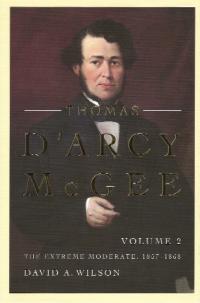Thomas D’Arcy McGee, Vol. 2: the extreme moderate, 1857–1868
Published in 1848 Rebellion, 18th–19th - Century History, Book Reviews, Issue 2(March/April 2012), Reviews, Volume 20
Thomas D’Arcy McGee, Vol. 2:
the extreme moderate, 1857–1868
David A. Wilson
(McGill–Queen’s University Press, CA $39.95)
ISBN 9780773539037
If you enjoyed the first instalment of David A. Wilson’s Thomas D’Arcy McGee biography (HI 16.6, Nov./Dec. 2008, reviews, p. 65), you’ll want to take a look at this second and concluding volume. Picking up the story from McGee’s 1857 arrival in Montreal, the author remains fundamentally sympathetic to his subject while avoiding the temptation to don blinkers. As the introduction puts it: ‘In the pages that follow, the reader will find numerous examples of McGee cutting moral corners to attain his political objectives’.With a trajectory that runs all the way from Irish republican revolutionary to ‘father of Canadian confederation’, McGee’s story has plenty of drama. And in a dramatic finale, he was assassinated while walking home from the Canadian House of Commons in the early hours of 7 April 1868. The following week, on what would have been his 43rd birthday, his funeral in Montreal was the largest British North America had ever seen. Psychologically, McGee was on the run when he arrived in Montreal in 1857. After escaping from Ireland in 1848, he became a prominent Irish-American Catholic advocate. But disillusionment followed. Not only was the United States rife with what he saw as anti-Irish discrimination but it was also a place where Irish Catholic immigrants were likely to lose their moral footing and their faith. And as Catholicism was the paramount thing in McGee’s life, this just wasn’t on. So he looked north for somewhere that might provide the social and political space to nourish Catholic values. Separate denominational schools were a big part of the attraction.In Wilson’s telling, this search for space had wider implications for subsequent Canadian history. McGee’s principle of maximum freedom of belief was to extend to all religious groups, thereby helping ‘to open the door for modern multiculturalism’. After entering politics, McGee became the main spokesman for ‘a new northern nationality’. Politically, it was to be expressed as a ‘federal arrangement that would encompass all the British colonies in North America and take over the Hudson’s Bay Company’s territories in the West’. But security required a blend of maximum legislative autonomy with membership of the British Empire. The man who had been a vigorous Anglophobe had come to see things in a different light. In effect, British power was to be the guarantor of the new country’s independence from the United States. It was a startling journey for someone who had previously embraced the idea of American annexation of Canada.Irish readers will be particularly interested in the chapters dealing with McGee and Fenianism. It was to be the issue that cost him his life. At the end of the American Civil War, the Fenian Brotherhood looked to the thousands of Irish-American ex-Union Army soldiers as a potential strike force. And the British colonies in Canada were perceived as a soft target. Invasion and conquest might impel Britain to do a deal on Ireland. Or it might trigger war between Britain and the United States, thereby curtailing the ability to suppress a Fenian uprising in Ireland.Three such invasion attempts were made in 1866; all fizzled out. But as a vociferous critic of the Fenians, McGee made bitter enemies in some segments of the Irish-Canadian Catholic community. While traditional Canadian historiography tends to see the Fenian threat as external, Wilson notes that they had the sympathy and support of a significant minority of Irish-Canadian Catholics, including Patrick Boyle’s Irish Canadian newspaper. Actual Fenian membership may have been no more than 3,500, but the number of fellow travellers extended substantially beyond that. Indeed, the Fenians in Montreal reckoned that they could draw on the support of a quarter of the city’s (mostly Catholic) Irish-born population.The rhetorical war started in earnest in the spring of 1864, when McGee described Fenian leader John O’Mahony as ‘incurably insane’ and the Irish Canadian struck back by characterising McGee as a ‘truckling traitor’. Then in May 1865, while back in Ireland in an official Canadian government capacity, McGee upped the ante by describing the Fenians as ‘Punch-and-Judy Jacobins’. And although he concurred with the decision to commute the capital sentences imposed on captured Fenians in the aftermath of the failed invasions, he also publicly declared that ‘those men deserve death’.By the time of his assassination, McGee’s political star was in decline. The intricate balancing effort required to construct the first post-confederation federal cabinet saw him left on the sidelines, and his personal re-election fight in Montreal was much closer than he had anticipated—the battle against Fenianism having cost him the support of the majority of Irish-Canadian Catholics in his constituency. Inevitably, the aftermath of his murder created its own controversy. Patrick James Whelan, an Irish immigrant tailor, was convicted and hanged. But was he guilty? Reviewing the evidence, Wilson concludes that under ‘the criminal law criterion of reasonable doubt, he should have been acquitted’. By the same token, under ‘the civil law criterion of the balance of probabilities, he was involved in the murder of Thomas D’Arcy McGee, either as the assassin himself or as an accomplice of the assassin, and he should have been found guilty’. All in all, it’s a gripping story. HI
A native of Dublin, Pat Murphy has lived in Toronto since 1965 and writes a regular column for Troy Media.
















